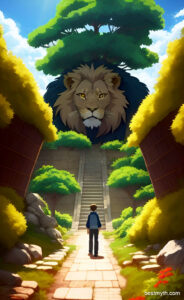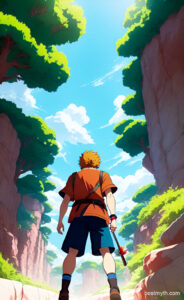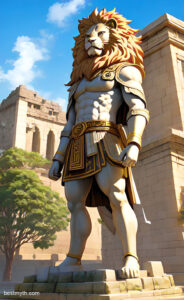Act 1: The Discovery
The story takes place in the Ach Valley, a wild and inhospitable region of Paleolithic Europe, where a group of nomadic hunter-gatherers struggles to survive. Among them is a young man named Kael, gifted with keen observation skills and insatiable curiosity. Kael is known for his ability to spot subtle signs in nature and understand animal behaviors. He is also a talented artist, creating cave paintings and jewelry from materials found in nature.
One day, while exploring the rocky walls of a deep cave called Hohle Fels, Kael notices something strange in the darkness. Using a rudimentary torch, he ventures deeper into the cave until he discovers a small hidden cavity. There, lying in a recess in the rock, is the ivory statuette of a mammoth.
Kael retrieves it carefully, his fingers grazing the smooth, cold material. He is immediately struck by the precision of the statuette’s details, depicting a creature that is half-human and half-feline, with a majestic mane framing its face. The creature’s eyes seem to pierce the darkness of the cave, almost appearing lifelike.
Kael’s wonder is indescribable. He knows he has discovered something truly extraordinary, a work of art of unimaginable beauty dating back to a distant time. He decides to bring the statuette back to the tribe to show it to his fellow tribespeople, unaware of the repercussions it will have on his life and on his community.

Act 2: The Magic of Art
Back in his camp, Kael presents the lion-man statuette to his tribe. The captivating object sends shockwaves through the members of the clan. Elders, hunters, women, and children gather around Kael to gaze upon this enigmatic work of art, a creation thousands of years old.
Heated discussions erupt. Some whisper that the statuette could be a gift from the spirits or a manifestation of the magic of nature. Others debate the meaning of the half-human, half-feline creature, wondering if it represents a protective deity or a mythical creature.
The elders of the tribe, however, see more than that. They recognize the significance of art in the life of their people. They explain that art is not just an expression of creativity but also a means of preserving and transmitting knowledge and stories. They insist that this statuette is a treasure that must be preserved for future generations.
The atmosphere in the camp becomes imbued with respect and mystery. Clan members come regularly to admire the lion-man statuette, touch it with reverence, and ponder its meaning. Stories begin to circulate about its origin, fueling the collective imagination of the tribe.
The lion-man statuette becomes a symbol of the importance of art in the lives of early humans, a source of inspiration for budding artists, and a reminder of the magic that can reside in a simple work of art. It brings the tribe closer together, strengthening the bonds between its members and sparking conversations around a fire and endless debates about the role of art in their prehistoric existence.

Act 3: Jealousy and Theft
As the weeks pass, the lion-man statuette continues to captivate the tribe, adding a new dimension to daily life. Kael has become a respected figure within the community, recognized for his extraordinary discovery. However, this newfound recognition also stirs jealousy in some members of the clan, especially in Thoren.
Thoren is a man of envious nature, who has never managed to attract as much attention as Kael. His fragile ego drives him to covet the statuette, which he sees as a means to gain prestige within the tribe. His thoughts are haunted by the idea that the statuette could bring him the recognition he so ardently desires.
One day, while Kael is out hunting with other tribe members, Thoren decides to take action. He knows that the statuette is kept in a secret location within the camp, but he has been closely observing Kael’s movements and knows where it is hidden. Taking advantage of Kael’s absence, Thoren skillfully steals it and hides it in a place he hopes will remain unknown to all.
When Kael returns from the hunt and discovers the statuette’s disappearance, he is plunged into deep despair. He knows that the statuette is much more than a mere object to him; it’s a symbol of his discovery, his creativity, and his connection to the tribe. Kael suspects that someone from the tribe is responsible for the theft, but he cannot fathom that it might be one of their own.
The tribe, unaware of the true identity of the thief, is now divided between those who believe the statuette is lost forever and those who hope it will return one day. Thoren, on the other hand, becomes increasingly obsessed with the statuette and its alleged powers. Jealousy and covetousness drive him down a dark path, threatening the cohesion of the tribe.

Act 4: Kael’s Quest
The tribe is plunged into confusion and sadness following the disappearance of the lion-man statuette. Kael, on the other hand, feels a deep pain, a loss that goes beyond the mere materiality of the object. He is determined to find the statuette, bring it back to the tribe, and restore harmony within the community.
Kael begins his quest by discreetly questioning members of the tribe, seeking clues that might lead him to the thief. He knows that the statuette holds particular significance for each person, and he hopes that someone might crack under pressure and reveal valuable information.
He soon uncovers rumors circulating among the younger members of the tribe, whispers suggesting that Thoren, a fellow tribe member, was seen secretly in possession of the statuette. Kael decides to follow this lead and confront Thoren.
The confrontation is tense. Thoren initially denies any involvement, but in the face of Kael’s persistence and the mounting circumstantial evidence, he eventually confesses to his actions. He explains that he was driven by jealousy and the desire to receive the attention he had longed for.
Kael, while saddened by Thoren’s betrayal, feels empathy toward him. He understands that jealousy can drive people to commit regrettable acts. Instead of seeking revenge, Kael decides to show mercy to Thoren, reminding him of the importance of community and the need to work together for the greater good.
Together, Kael and Thoren decide to return the statuette to the tribe. However, they understand that this act must be accompanied by a gesture of reconciliation toward the other members of the tribe. They organize a forgiveness ceremony where Thoren apologizes for his actions.
The tribe reacts with unexpected compassion, recognizing that jealousy can affect anyone. The statuette is eventually recovered, but it doesn’t simply return to its place in the camp. It becomes a symbol of a valuable lesson in conflict resolution and the strength of the community. Kael and Thoren, once rivals, become living examples of reconciliation and unity within the tribe.

Act 5: The Return of the Statuette and the Mystery of the Ancient Civilization
The lion-man statuette is finally back in the tribe’s camp, brought by Kael and Thoren at the end of their quest for reconciliation. But its return is accompanied by an even deeper mystery that arouses everyone’s curiosity.
As the tribe celebrates the reconciliation between Kael and Thoren, the statuette is placed in the center of the camp, in plain view of all. However, it quickly becomes evident that the statuette is not just a simple carved object. It is adorned with engravings and enigmatic symbols that intrigue the tribe members.
Kael, who has always been fascinated by art and history, is the first to study the mysterious symbols. He recognizes some of them as similar to those found in ancient caves in the region. This suggests that the statuette could be a relic from an ancient civilization, a civilization whose knowledge and culture have been lost for millennia.
The tribe decides to conduct an investigation to learn more about this ancient civilization. Kael, Thoren, and other members of the tribe embark on archaeological excavations around the camp, discovering artifacts and inscriptions that appear to be related to the mysterious civilization.
Gradually, a portrait of this ancient civilization begins to emerge. They had advanced knowledge of art, astronomy, and architecture, and they revered animals such as the lion-man. The tribe members wonder how such an advanced civilization could have disappeared, and if they could learn something valuable from its lost teachings.
The statuette, once a symbol of conflict and jealousy, now becomes a link between the present and the past, between the current tribe and the ancient civilization. As the tribe delves into uncovering this ancient mystery, they strengthen their cohesion and their understanding of the importance of preserving knowledge and culture for future generations. The lion-man statuette thus becomes a symbol of wisdom and unity, reminding everyone that even conflicts can lead to unexpected discoveries and reconciliation.

Recent Posts
- Maraud the Corsair February 7, 2024
- The Archer Phéo February 5, 2024
- The Kingdom of the Florilins October 23, 2023
- The Book of Destiny October 20, 2023
- The Book of Eons October 17, 2023
- The Founders of the Depths October 16, 2023

